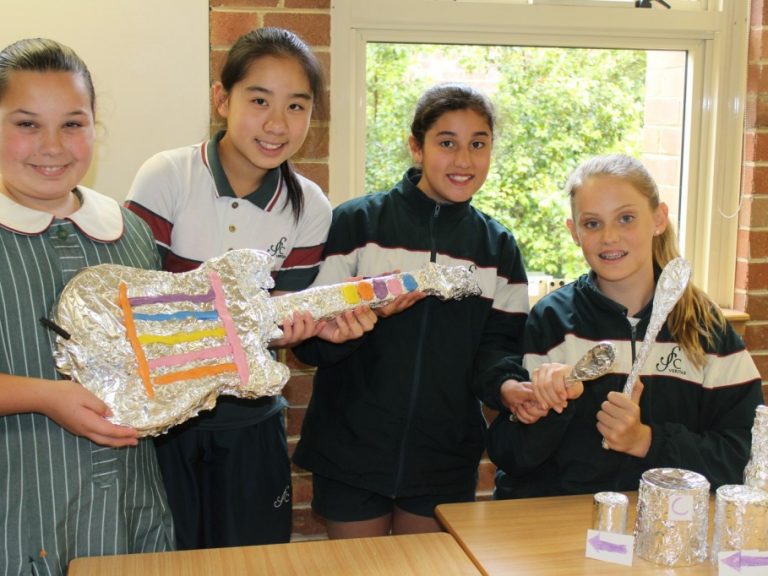AGQTP Project – Learning through Making with Digital Technologies
Project Rationale & Background:
“In the late 1960s, Seymour Papert began asking, ‘Does the computer program the child or the child program the Computer?’ ….personal fabrication, programming and physical computing shift the emphasis from passive consumption to active creation and invention.” Libow Martinez & Stager (2013)
Inspired by the maker movement and “Invent to Learn”, which emphasises the need to bring game-changing technologies (fabrication, physical computing & programming) to K-12 classrooms we undertook a series of learning experiences to give students the opportunity to learn by making, tinkering, prototyping, engineering & using computational thinking. We also considered the focus in the ACARA Digital Technologies draft curriculum, which moves to students learning how to develop digital solutions. This culminated in a ‘maker’ day with our Year 6 students having the day to plan, make, invent, & share their own ‘maker’ digital technology project.
Process:
The process of the project involved a number of stages:
- Tinkering workshops were held with all Year 6 classes to expose them to the technologies – Makey Makeys, e-Textiles, Scratch & Turtle Art.
- Planning – Brainstorming of interests & ideas for Maker Day, Student choice, forming groups based on common interests
- Maker Day:
- Session 1: Invent, Plan, Experiment, Problem Solve
- Session 2: Make, Create, Test, Modify, Video Process
- Session 3: Present, Share, Reflect.
Findings:
The ‘Maker Day’ experience was filled with lots of enthusiasm, experimentation, persistence and joy. The students were interviewed about the learning experience and asked to give feedback.
Structure – Did you like the open structure of the day?
It was good that it was open so we could do it at our own pace…even though you set little sections, sometimes it took longer to plan something. For us, we had to change our whole idea so it was good it was open.
Being an Inventor – Did you enjoy being an inventor?
I liked how everyone got a chance to express what they thought they could do and use their minds in an open way. I would have never known about e-Textiles, Makey Makey, Scratch or Turtle Art and here we could learn things and get the experience to do this.
I liked how we all have different groups and we got to pick different things to make. We had choice of what we did
Thinking – Were you thinking differently?
We had to be a bit more creative, ours wasn’t working and it was frustrating. We had to keep positive and we had a lot of patient thinking.
Our Maker Day was authentic example of what Seymour Papert once described as “hard fun” as the essence of good games and good education.
“Once I was alerted to the concept of “hard fun” I began listening for it and heard it over and over. It is expressed in many different ways, all of which all boil down to the conclusion that everyone likes hard challenging things to do. But they have to be the right things matched to the individual and to the culture of the times. These rapidly changing times challenge educators to find areas of work that are hard in the right way: they must connect with the kids and also with the areas of knowledge, skills and (don’t let us forget) ethics, adults will need for the future world.” Papert (2002)
Some of the student feedback from the day included:
Maker Day was very inspirational, as a young inventor I learnt that a Makey Makey has infinite possibilities to work with and I would like one for Christmas.
I think Maker Day was a great opportunity for us to use our brains in a different and unique way. Also I think it was fun to do something a little bit different and it was a great way to move out of our comfort zone. I really enjoyed trying Scratch, e-textiles and Makey Makeys.
I think Maker Day was so much fun and exciting. We had to try things we had never done before. I learnt how to stitch on a led light.
I found Maker Day very exciting and I enjoyed that the whole grade got together to make things. I learnt how to make a game with play dough. Overall I thought the day was great and we should have more days like this.
A group of students also presented our findings and experience at the International Conference on Creativity and Academic Excellence held at Knox Grammar.
Recommendations for further learning:
From this learning experience and feedback from students and staff we have the following recommendations to continue the “Maker” experience at Santa Sabina College
- Establish a “Maker Space” in Library – this will consist of Makey Makey’s, Arduino Kits, Raspberry Pi’s, Software design, 3D modeling and printing capabilities. Set up as a true “Maker Space” that allows students to tinker and invent with digital technologies without formal structure.
- Make Connections with Expert Makers & groups in Sydney – Robogals, Hackerspaces, Electrocraft, Thinkspace.
- Participate & Collaborate Globally – hour of code initiative 2013, blogs, contribute and share screencasts and tutorials,
- Contribute to Maker Faire Movement – aim to participate in next Sydney Maker Faire.
Angela Thomas
References:
ACARA (2013) Draft Australian Curriculum: Technologies www.acara.edu.au
Libow Martinez, S. & Stager, G.S. (2013). Invent to Learn: Making, Tinkering & Engineering in the Classroom.
Torrance, CA: Constructing Modern Knowledge Press.
Papert, Seymour. “Hard Fun”, Bangor State News. (2002) Available at: http://www.papert.org/articles/HardFun.html



